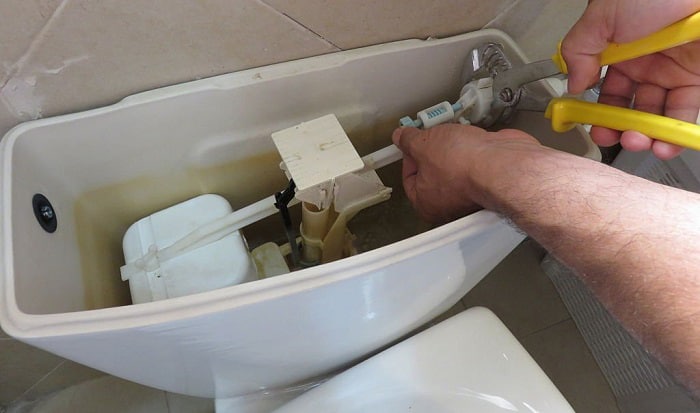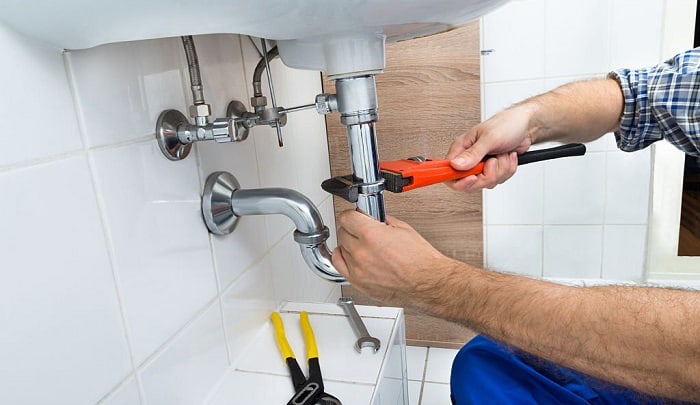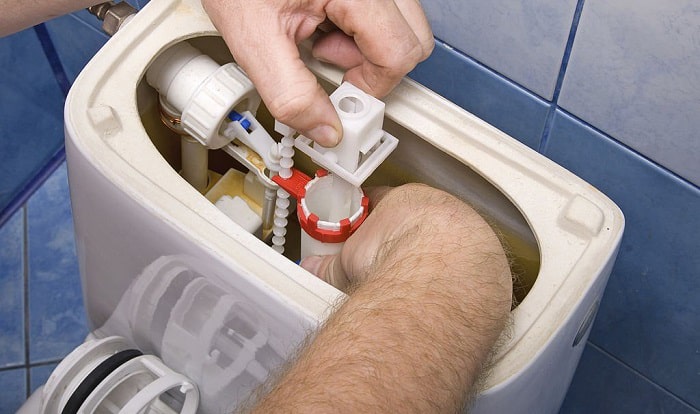A ball float blocks the water from coming out of the toilet fill valve if you don’t press the flush lever. However, modern toilets don’t have a floating ball and connecting rod as they have a new style and design.
So, how to fix a running toilet without a ball float? To stop a running toilet, you need to check the toilet tank and see if the fill valve is closed properly.
Another reason is that there’s an issue with the overflow tube and water level. There might be faulty toilet components that need to be fixed or replaced. To stop your toilet that keeps running after a flush, read the whole article.
A Step-By-Step Guide to Fix a Running Toilet Without a Ball Float
If you have no idea how to stop running the toilet without float ball, you have to know what you need for the task, the right steps, and how things work within the toilet tank.
What to prepare
- New fill valve
- Adjustable wrench
- Pliers
- Bucket
Step 1: Understanding how a toilet without a float ball works
A modern toilet has a fill valve instead of a float ball and rod or float arm. The need to fix a toilet fill valve that keeps running is much easier than the toilet float repair.
Despite the different names and forms, they both have the same function. The advantage of the toilet valve is that it’s more compact than the ball valve. It also means there’s more work when you have a toilet float that doesn’t stop water from coming out of the flush valve.
When you have a tank with no toilet float that keeps running, you should examine the fill valve that is situated on its left side. It works with a refill tube when refilling the tank. Both of them ensure the right height of the water every time the flush valve opens.
In terms of saving water, a modern dual flush toilet proves to be efficient. It works with a button flush. There are two buttons to be specific as there’s a lower amount of water for liquid waste. This is the revolutionized flush handle that is seen on older models.
You’ll also find a float cup valve that assists the automation of the refill tube. It clings to the vertical body of a flush valve. In addition, a float cup creates the necessary water pressure when flushing the toilet. It stops the water level from rising or else, you will need to have an overflow pipe.
Unlike the ball float, the fill valves are quiet. The former is so noisy as it releases water that sounds like waterfalls. However, they share something in common. Both fill valve and toilet tank float replacement call for assembly of the entire system.
Before getting started, get everything you need from a local hardware store or online from a reputable website. If you’re not sure about these things, go to the local store and ask for help from a store representative.
Step 2: Fill valve assembly
It’s recommended to have a new fill valve every 5 or 6 years. A new flapper is usually required for valve replacement. The running toilet flapper offers constantly running water. If it appears that it’s not shutting off the water, there will be a hike in your utility bills.
For complete replacement, you have to get a new valve that has a fill tube, lock nut, and at least a single gasket. The wrench and pliers are essentials in some cases.
Step 3: Shutting down the water supply valve
As with any other plumbing work, you have to shut down the water flow and the valve is at one end of the water supply line. Once you find the valve, twist it using your fingers.
You’ll find it hard to move a rusty valve but a pair of pliers can make it easier. Do it slowly so you won’t cause further damage to the valve. It helps to turn off the water supply line once a year to prevent rusting.
Before shutting down the water supply, flush your toilet. You have to empty the tank or it’s like a toilet bowl without a tank before you can start the new valve assembly. Let the bucket catch the leaks.
Step 4: Removal of an old valve
If the base of the old fill valve is not too worn out or torn, the replacement will be much simpler. You’ll find a lock ring at the valve’s base so you have to put some effort into it. This ring allows you to pull the valve upwards and take it out of the base.
When the said components become rusty, the valve needs to be soaked in vinegar so you can separate it. You have to remove the existing base if it’s rusted and damaged. Otherwise, you can proceed to the new fill valve installation.
Step 5: Valve installation
The new valve should match your toilet model. Some YouTube videos can be a guide or you can go to the local store and ask for advice from the store representative. Given that you don’t need a new base, you can directly place the valve and refill the tube.
It can be done in seconds but make sure you go over the ring as well to ensure that all the components are stable. Then, put the refill tube and overflow tube together. Although it’s the job of the overflow tube, see to it that the water level setting is not too high. It’s a crucial factor so overflowing won’t take place.
Step 6: Base replacement
This part is a guide for those who need to replace the base of the valve. It’s a straightforward process but there’s nothing wrong if you want to be precise and guided.
As mentioned in the previous task, you have to flush the toilet to remove the excess water. The tank should be empty or like without a tank at all as water is unnecessary for this project.
You’ll need a bucket to catch the water that drops from the water supply hose. Then, you can unscrew the hose at the base of the toilet tank. Next, remove the lock nut using the wrench.
Once the old base is unlocked, you can take it out from the toilet cistern. It’s not useful anymore so you can throw it into the trash. After placing the new base, you can refer to step number 5 for the valve installation. Again, be mindful of the water level once the installation is done.
FAQs
Why does my toilet keep running even after replacing the flapper?
One of the solutions for a toilet that doesn’t have a ball float and keeps on running is flapper replacement. The flapper goes over the drain hole and below the overflow tube. However, flapper replacement can’t solve it all the time. It all goes back to the flush valve that might be pitted or rough.
On the other hand, you can buy a flapper kit that features flush seat repair to replace your worn-out flapper. Aside from the flapper, it comes with a seat that can match the damaged one as well as the necessary adhesive.
After you install the flapper, you have to adjust the flapper chain appropriately. This chain just needs to slack a little when the flapper is at rest. You can determine the correct length by trial.
You have to begin with flushing the toilet. Touch or fiddle the chain to see if there’s an excess length you need to cut. Cutting the indispensable length will prevent the chain from getting stuck in the flapper.
Why does the toilet flapper stay open?
Here are the reasons why the toilet flapper stays open aside from being broken.
- The chain needs adjustment
A simple adjustment of the chain can close the flapper. Extra length can cause it to stick to the flapper. It’s not good if it’s too tight as it doesn’t have slackness to let the flapper close. If someone has done improper installation, remove the tank lid and check the chain’s tension.
- Excessive residue
Excessive residue around the flapper will happen if you use hard water. Apart from the residue, minerals and sediment can harden around its hinge so opening and closing become impossible.
- Too much air pressure
Too much air may travel through the pipes and affect the flapper. The flapper can only move once the excess air is gone.
- The incorrect size and weight
A flapper replacement should be in the correct size and weight. If it’s heavy, it can’t sink to make the seal. The lack of weight can prompt it to stick upwards and prevent it from closing.
Wrap it Up!
How to fix a running toilet without a ball float? This question simply refers to the modern toilets that work with a fill valve instead of a ball float. There’s no need to hire an expert to fix the problem as valve replacement is easy. You won’t sweat a lot even if the base needs to be replaced.

I’m Paulk Webb, and I work as a writer for Saveourwaterrebates. I’m happy to put in the time and effort to conduct market research to identify the most pressing issues faced by households concerning their plumbing. Feel free to check out our guides to get the most informed recommendations for how to solve your problems.




